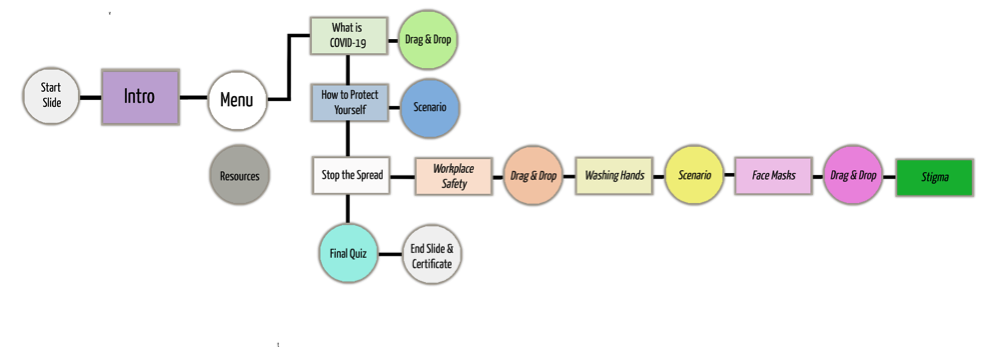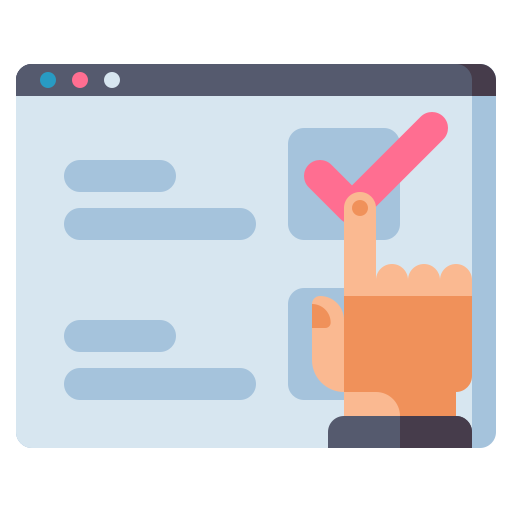
Online learning experience for COVID-19 safety
Better safe than sorry!
After understanding the client’s goals, my digital solution increased user satisfaction by 24% when they engaged with an online learning experience. This experience gave users certification that instilled trust in customers.
Overview
100% of our target users completed the online learning experience within 2 weeks!
I worked with a consumer products company to meet their goals. Ultimately, the final result created strong engagement among Field Sales Representatives when learning about COVID-19 best safety practices. As a result, this increased customer trust within the client’s brand and employees.
When compared with other virtual training courses the company has released in the past, overall user satisfaction increased by 24%!
This project was worked on using agile design methodology. I worked within a sprint format to meet the client’s very aggressive timeline.
Client: Fortune 500 Company
I worked with a consumer products fortune 500 company. Due to an NDA agreement, I am unable to reveal the company’s name. The client requested my services to create an engaging online experience where Field Sales Reps can learn about COVID-19 safety best practices.
Team
I worked with a team of developers, a project manager, animators, and illustrators.
My Role
I worked as the sole UX/UI designer and content creator for the project. I conducted research and designed the interface from the ground-up.
eKickoff
Client Needs and Goals
Three of the client’s business units, which have Field Sales Representatives, needed to prepare their employees to return to their typical work as they transition out of the COVID-19 quarantine. Their ultimate goals were to:
Ensue their employees remain safe, protect themselves and customers from infection.
Ensure customers have trust within the business and feel peace of mind when allowing Field Sales Reps into their place of work.
The Challenge
I was tasked with creating a solution that would remotely train Field Sales Reps in COVID-19 best practices. The training must be engaging to ensure retention of the information.
Research
My research preference was to conduct user interviews with the target users. Unfortunately the client did not have the time or budget for me to conduct user interviews.
Instead I referenced existing data related to infectious disease safety training. After synthesizing my findings, I found the following insights:
Users must have an understanding of the disease before they can learn how to prevent infection
Safety is about knowing how to protect yourself, as well as taking measures to protect others
I also performed a comparative analysis by looking into how other companies were training their employees on COVID-19 safety and how this training was received. After synthesizing my findings, I found the following insights:
Trainings were very text heavy, which made them tedious and hard to follow
The trainings were very long (over an hour) and provided too much detail. This information overload led to poor retention rates.
The evolution of information on the topic as the COVID-19 Pandemic continues presents a challenge regarding up to date information.
What does it all mean?
How might we quickly create an engaging training that will effectively teach learners to implement COVID-19 safety best practices.
In order to create an effective online learning experience, I needed to learn from the shortcomings of past courses that I researched. This is why my team and I needed an answer to this question:
How might we quickly create an engaging training that will effectively teach learners to implement COVID-19 safety best practices.
The Solution
An online learning experience that’s short, concise and full of customized visuals to reinforce concepts and maintain engagement.
Overall Course strategy
Have a structure that starts broad, and then narrows down into more specific guidelines as the learner progresses. This is because it is important the learner first receives a general understanding of COVID-19 before they begin learning specific guidelines for safety.
The course then provides a high-level overview of how learners can protect themselves. This prepares them to then delve into more detailed guidelines regarding the most important methods of protection and prevention of infection.
In order to increase the likelihood of course success, I planned to ensure the course had these attributes:
Simplify the content down to the core messages. This ensures the use focuses on what’s important and not the ancillary details
It’s short, under 15 minutes, to maintain user attention
Presents concepts in bite-sized chunks within several modules. Information is presented in a combination of videos and interactive activities. This diverse presentation helps maintain user engagement
Tracks progress to show create key milestones to ensure learners feel a sense of accomplishment
Provides a menu that facilitates fluid navigation
Includes a final quiz to ensure information retention
Ensures the training can live in the client’s LMS system. This gives all the target users access, while keeping the course internal to the client’s company
Information Architecture
IA for the online learning experience.
The course starts high-level and then narrows into specific details. First there is an introduction to prepare the user for the upcoming experience. Then the course is broken down into three parts: an overview of COVID-19, information on how the user can protect themselves, and finally, more specific methods of stopping the spread of the virus.
Circles indicates pages where the learner must interact with interface or complete an interactive activity to move forward. Rectangles indicate short videos with bite-sized nuggets of information.
The Design
Unfortunately, I cannot share the design for the project due to an NDA.
I conceptualized the designs for the entire course. Then I worked closely with a team of illustrators in order to create the custom images needed for animated videos and interactive activities. I also worked with animators and developers to bring these designs to life.
The navigation is clear with buttons for returning to the menu or moving forward and backward within the course.
Outcome
100% completion rate in two weeks!
Since the release of the online training, all the target users (over 300 people) completed the course and passed the quiz within two weeks. This speed is less than half of the average course completion times for the client’s other virtual trainings.
89% Overall user satisfaction!
Based on surveys for the clients past online virtual trainings, user satisfaction was at about 65%. Our research shows that the COVID-19 Safety Best Practices course had an 89% user satisfaction score! This is a 24% improvement, indicating that learners see the value of the course and would recommend it to others.
90% of users putting what they learned into practice!
What’s more, after taking the training, the client observed that about 90% of target users were actively incorporating what they learned, a huge success.
So now what?
Next steps
I advised the client to work with me to keep the training updated as the CDC COVID-19 guidelines evolve.
Future Plans
I plan to work with the client to in a similar sprint format for their future projects.
Conclusion
With a very aggressive timeline, I was able to design a high-quality online learning experience for a Fortune 500 company. I was able to meet the client’s goals by creating an engaging training that effectively taught Field Sales Representatives COVID-19 safety best practices. While more time would have been ideal, I was able to work in a sprint format to produce an MVP that met the client’s needs.











